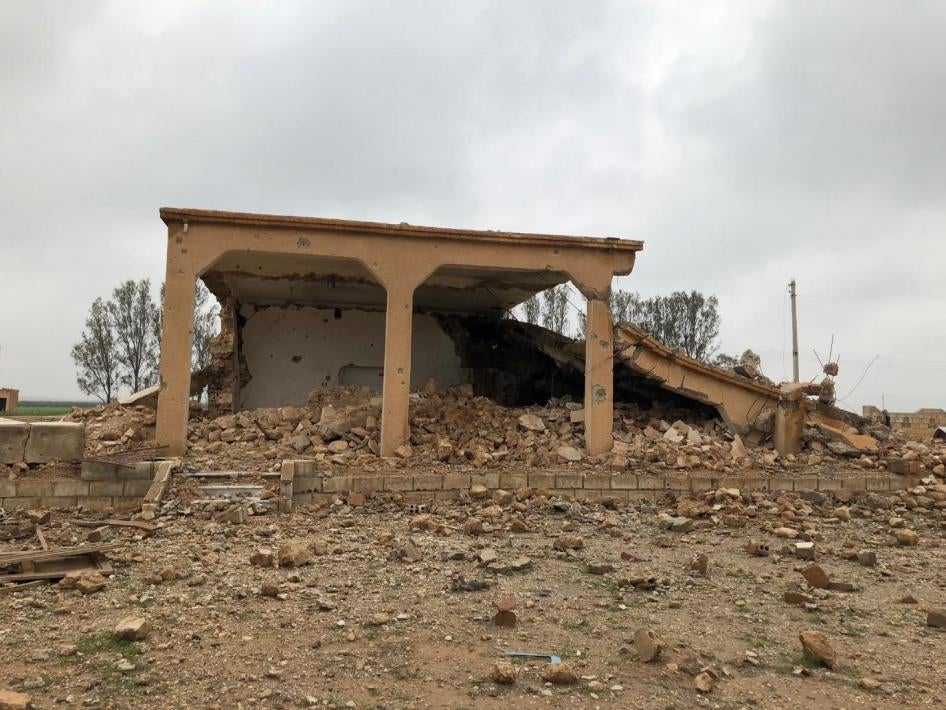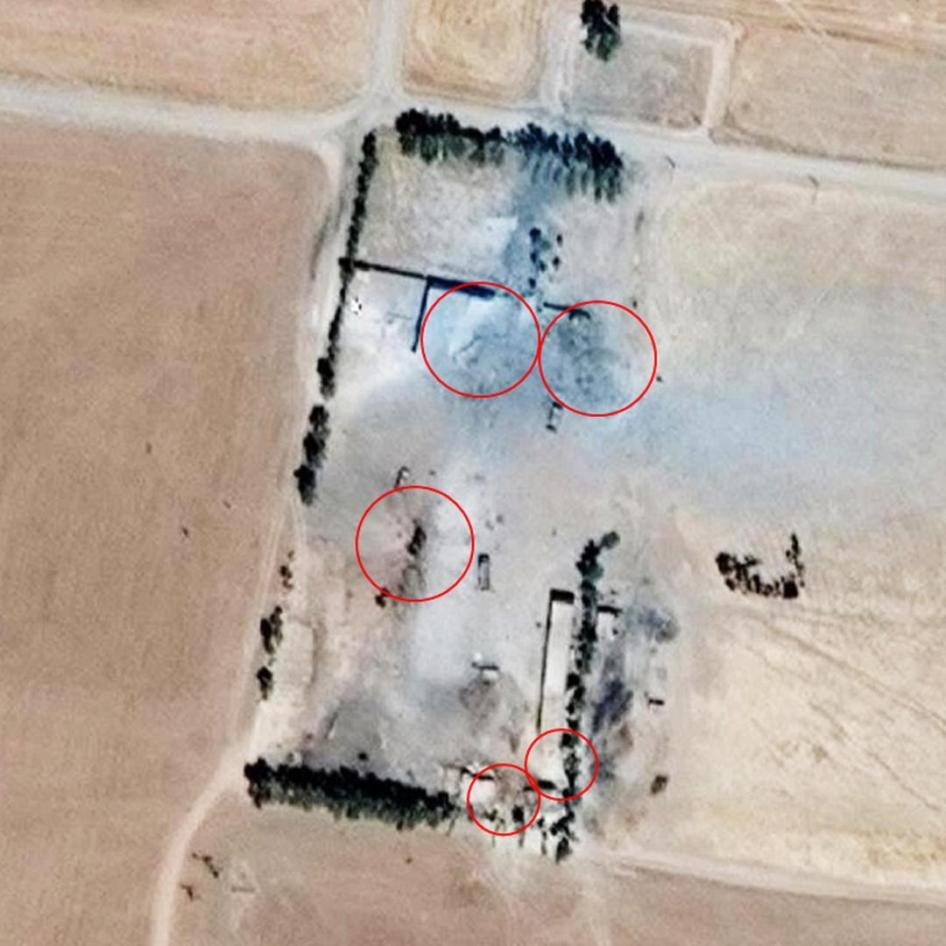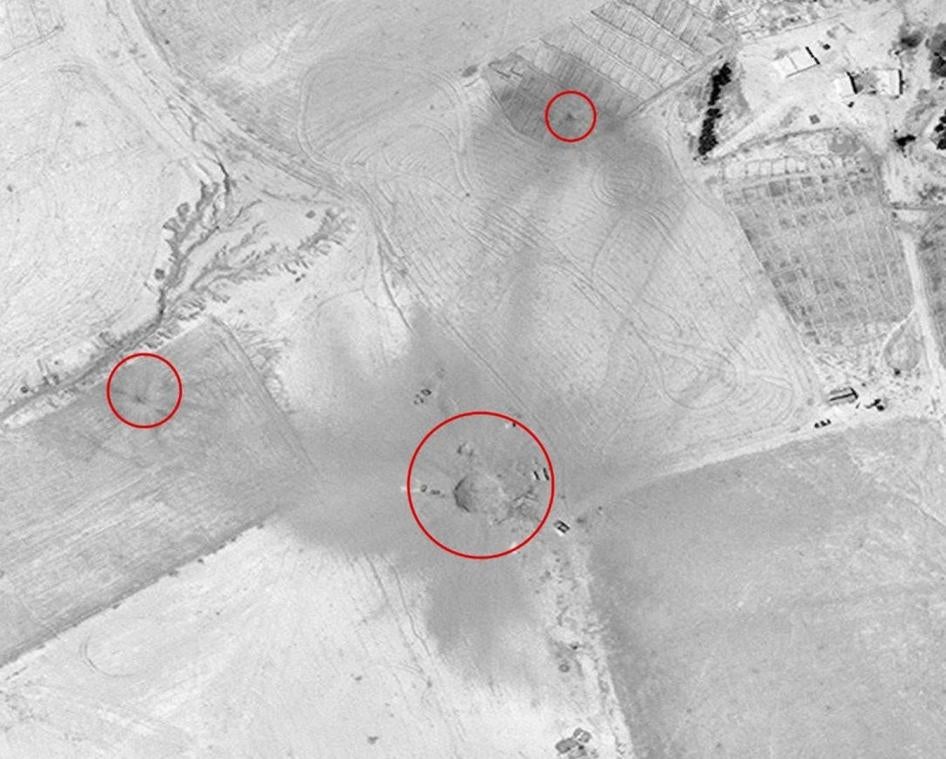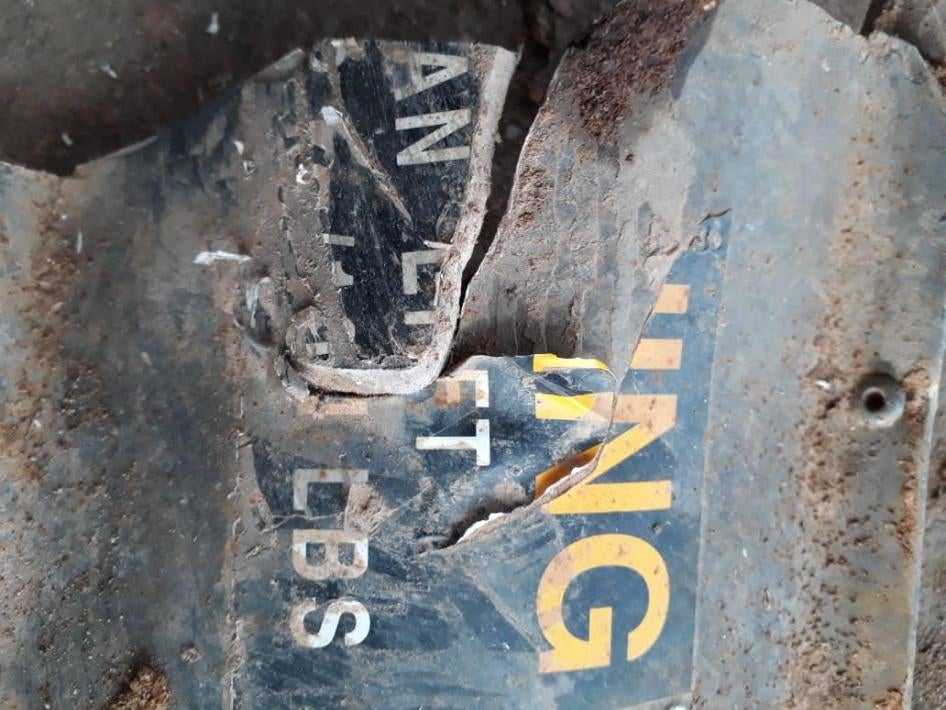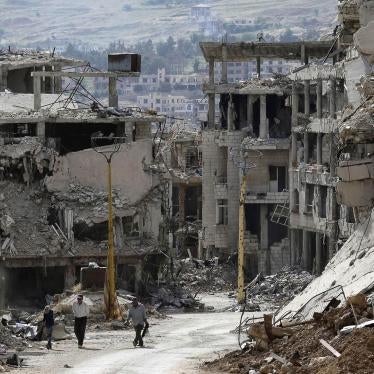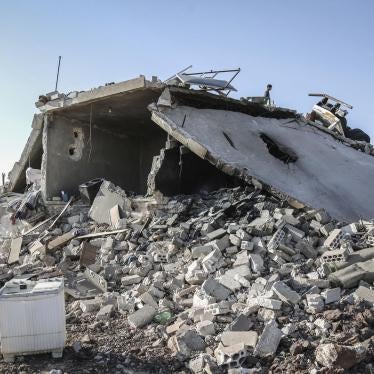(Beirut) – The United States-led coalition against the Islamic State (also known as ISIS) should address the harm to civilians during military operations in Syria, Human Rights Watch said today. Independent investigators have reported that coalition airstrikes killed at least 7,000 civilians in military operations in Iraq and Syria since September 2014.
The coalition apparently provided approximately US$80,000 to victims of a January 2019 attack that killed 11 civilians, including 4 children from the same family. However, Human Rights Watch investigations into 4 apparently unlawful coalition airstrikes in al-Hasakeh governorate in 2017-2018, which killed 63 civilians and damaged and destroyed property, resulted in no compensation or payments to victims. On March 23, the coalition and the Syrian Democratic Forces (SDF), the allied Kurdish-led forces, announced that they had seized control of the last ISIS pocket in Syria.
“While active fighting against ISIS may be over, civilians harmed by coalition strikes are still suffering,” said Lama Fakih, deputy Middle East director at Human Rights Watch. “The coalition should extend the payments made in January to civilians harmed in other actions in Syria.”
The coalition has not thoroughly investigated the attacks that killed civilians or created a program for compensation, “condolence” (or ex gratia) payments, or other assistance to civilians who suffered harm from coalition operations. The US Defense Department has attributed the lack of such payments to “practical limitations” and “limited US presence, which reduces the situational awareness required to make ex gratia payments.”
The condolence payments following the January 3 air attack in al-Khushkieh, Deir el-Zor show that the coalition can provide prompt assistance to affected families. These payments were agreed upon after a January 28 meeting of members of the coalition and the SDF with representatives of the families, local officials, and leaders from the Shu’eitat tribe, a prominent tribe in Syria, according to local officials, residents, and local news reports.
Human Rights Watch conducted field investigations in February for four coalition airstrikes from 2017 and 2018 in northeast Syria that resulted in the deaths of several dozen civilians. One airstrike may have been carried out by the Iraqi air force, a coalition partner that has also conducted unilateral strikes.
Three of the strikes appeared to be unlawfully indiscriminate, not distinguishing between military targets and civilians. The fourth appeared to cause disproportionate civilian harm compared to the expected military gain. None of the victims’ relatives said they received payment or assistance. On May 29, the coalition responded to Human Rights Watch inquiries, indicating that it had not assessed civilian casualties in three of these strikes but would. It said it had opened an assessment into the June 12, 2018 strike.
“That strike took most of our men,” said a woman whose husband and sons died in an August 2017 attack on a mosque. “They died, and now their women and children are left to fend for themselves. The women without husbands are living together, and we have no one to support us. The few men that are left try to get a job but it is very far and very difficult.”
The US and some other coalition members have made payments to victims of military operations in Afghanistan and Iraq, not as compensation for wrongdoing but as a voluntary gesture to ease civilian suffering. They are referred to as condolence or ex gratia payments, to emphasize that there is no legal obligation to make them. While the US Congress authorized the Defense Department in the annual National Defense Authorization Act (NDAA) to make condolence payments to civilians in Syria in December 2016, the process for making claims has not been defined.
The US should promptly develop a standardized condolence payment process and conduct outreach as feasible with affected communities to explain and publicize the process. The process should allow safe and convenient avenues to submit claims in the person’s preferred language and should identify local partners as facilitators. Condolence payments should reflect the circumstances, needs, and preferences of affected civilians. Options may include public acknowledgement, apologies, monetary payments, and livelihood assistance.
No other coalition member has apparently provided compensation or condolence payments in Syria, despite some acknowledging their strikes killed civilians. The United Kingdom maintains that its strikes in Raqqa and Mosul did not harm civilians. Australia only recently acknowledged civilian casualties in its airstrikes in Iraq. This raises concerns about the extent to which coalition forces are adequately tracking and assessing civilian harm, and whether lessons are being learned to prevent and mitigate future civilian harm.
Coalition members should coordinate their efforts to create a unified system to track, assess, and investigate reports of civilian casualties and to provide prompt and equitable condolence payments and other forms of amends, Human Rights Watch said. In cases in which coalition forces are found to have committed laws-of-war violations, appropriate compensation should be swiftly paid to the victims or their families.
“For the civilians who suffered under ISIS rule to rebuild their lives, the coalition should include condolence payments to those families who were harmed by their military operations,” Fakih said. “Providing victims of airstrikes with some help for their suffering would be an important step.”
Al-Hasakeh Governorate Airstrikes, 2017-2018
In three of the four airstrikes, coalition forces struck civilians and civilian objects where there was no evident military target. Such attacks are unlawfully indiscriminate under the laws of war. In the 2017 Al-Helo incident, coalition forces evidently took inadequate precautions to determine whether those attacked were civilians or fighters. The attack on a mosque filled with civilians was disproportionate in that the civilian loss exceeded any expected military gain from attacking three ISIS fighters.
Tal al-Jayer village July 4 or 5, 2017
GPS Coordinates: 41°1'56"E 36°3'38"N (MGRS: 37SFV 83039 92584)
On July 4 or 5, 2017, shortly after midnight, apparent US-led coalition airstrikes hit the compound of Zarkan Khalif Salem, a sheep trader in the village of Tal al-Jayer, al-Hasakeh, witnesses told Human Rights Watch. The strike hit the main house, killing a 90-year-old woman and a child, and wounding at least three other civilians. The family had been sleeping on the roof or on a nearby patio. Residents said that immediately afterward, a second strike hit a building nearby where Salem kept his sheep, killing about 40 sheep.
Fifteen minutes later, a rescuer arrived by motorcycle. He went to get a pickup truck for the wounded, the rescuer’s brother said. When he returned 15 to 20 minutes later, the plane struck his pickup, killing him and 10 other civilians. The brother of another victim said that six of those dead in the second strike were rescuers, and the remaining five were members of the family being rescued. Witnesses provided the victims’ names.
Human Rights Watch visited the site on February 9 and confirmed that three independent structures, including a house and vehicle, had been struck and partially destroyed. Satellite imagery reviewed by Human Rights Watch confirmed that between 10 a.m. on July 4 and 10 a.m. on July 5, 2017, there were three incidents corresponding to the witness statements.
The imagery reflects the apparent detonation of two large air-dropped munitions destroying two buildings in the north part of the compound corresponding to the structure that witnesses said was the house. The detonation of two, possibly three, smaller air-dropped munitions destroying one building and severely damaging a second in the south part of the compound corresponded to the sheep’s location. And a third reflects a probable airstrike on a vehicle, with damage signatures consistent with the detonation of a small munition.
Relatives and witnesses said there were no ISIS fighters among the house’s residents or ISIS bases nearby. They said the closest known military target was an SDF base 9 to 10 kilometers away.
The coalition reviewed the strike following a report by Airwars, an independent civilian casualties monitor, and found on May 31, 2018 that “[a]fter a review of available information it was assessed that no coalition strikes were conducted in the geographical area that correspond to the report of civilian casualties.” However, local residents said they saw the planes attacking. No other force was conducting airstrikes in the region as Iraq only began unilateral strikes in April 2018, and the Syrian-Russian military alliance was not operating in that area at the time. On May 29, 2019, the coalition told Human Rights Watch that it had opened an assessment into the alleged attack.
Family members and residents said that as of February 9, no official from the US-led coalition or the SDF had visited the site.
Al-Helo village, August 19, 2017
GPS Coordinates: 41°5'27"E 36°5'29"N (MGRS: 37SFV 88239 96098)
On August 19, 2017, at about 3:45 p.m., a US-led coalition airstrike hit the only mosque in al-Helo village, 16 kilometers from the Iraqi border. Witnesses said they heard the plane before the strike and watched as the mosque was hit. They said the mosque, with mud walls, was struck once and destroyed, and the plane circled over the village for about a half hour afterward.
The village is near an oil rig that ISIS controlled and guarded but was otherwise in a remote area. The strike completely destroyed the mosque, witnesses said, and killed at least 24 people inside for afternoon prayer. They said there were 21 civilians, whose names they provided, and 3 ISIS fighters who had guarded the rig.
Most of the village’s inhabitants are from the al-Jazza` family. The father of one victim said that there was no fighting in the vicinity at the time, though media reports indicate that the village was on the front lines. Witnesses indicated that ISIS occupied a house on the village outskirts, where the three ISIS fighters, who were Syrian but not local, had stayed.
Human Rights Watch visited the site on February 9 and observed damage consistent with the destruction of a single structure. Satellite imagery reviewed confirmed that a single building had been destroyed by the probable detonation of an air-dropped munition between about 10 a.m. on August 18 and 10 a.m. on August 20.
The father of one of the civilians killed said: “Nothing was left. I could not even find my son’s body. No one escaped alive. I could have been in that mosque that day. It could have taken us all.”
Residents said that many of the relatives of men killed in the strike – old men, widows, and children – have been unable to get jobs or provide for themselves without their heads of families. They have been forced to share accommodation and scarce resources.
The official website of the coalition’s Operation Inherent Resolve says that the coalition carried out a civilian casualty assessment of the strike but concluded that the media reports submitted to the coalition contained insufficient information of the time, location, and details to assess their credibility. As well as Human Rights Watch can determine, no other military force was conducting airstrikes in the region at the time. Residents said that as of February 9 no official from the SDF or the US-led coalition had investigated or contacted them, and the families affected did not know how to file a claim. On May 29, the coalition told Human Rights Watch that based on information provided they would assess the allegations.
Al-Helo village, June 4, 2018
GPS Coordinates: 41°5'22"E 36°5'46"N (MGRS: 37SFV 88096 96619)
On or around June 4, 2018 at 5 a.m., an airstrike hit a house on the outskirts of al-Helo village, killing 15 civilians, including 10 children, and injuring 2 more, according to witnesses and relatives of victims. Both the US-led coalition and Iraqi forces reported engagements near al-Shaddadi, where al-Helo village is located, at this time, Airwars reported.
Witnesses said that the plane dropped one large and later two smaller munitions. The first strike killed 9 of the 17 civilians in the house. Three survivors fled and were then hit in a strike outside the house. A third strike killed a man and two of his children who had survived the initial strike and were attempting to flee.
Witnesses said that they were concerned about follow-up strikes so only went to the strike site around 5 p.m. Only two victims there survived.
Human Rights Watch visited the site on February 9 and could identify a large crater where a house had been. Satellite imagery reviewed showed the destruction of a single building from detonation of at least one large air-dropped munition between about 10:30 a.m. on June 3 and 10:30 a.m. on June 4, 2018. Two additional detonation sites were identified during the same period corresponding to witness accounts.
Human Rights Watch spoke to one survivor of the attack and a witness from the village. They said that no ISIS fighters were in the house, which was located on a road leading to the oil rig under ISIS control. ISIS members guarding the rig often used the road.
One of the survivors said she had received medical treatment supported by the World Health Organization. However, she said that neither the SDF nor the coalition had contacted them or provided assistance, and that she did not know how to file a claim.
The coalition assessed the strike and found that “After a review of available information it was assessed that no coalition strikes were conducted in the geographical area that correspond to the report of civilian casualties.” On May 29, the coalition told Human Rights Watch that based on information provided they would assess the allegations.
Tal al-Jayer, June 12, 2018
GPS Coordinates: 41°1'42"E 36°2'47"N (MGRS: 37SFV 82717 90999)
On June 12, 2018, at approximately 9 p.m., several missiles hit a traditional one-story mud home in the small village of Tal al-Jayer, a survivor said. The strike killed 12 civilians, including 3 women and 6 children.
Human Rights Watch visited the site on February 9. The village is in a remote area with houses far apart. The house that was hit was part of a compound with two other structures nearby where the rest of the extended family lived. The survivor said that the first missile hit the living room of the house, where the 12 people who were killed were seated:
For a while I couldn’t hear or see anything, I was completely covered in dust. Then I heard crying. Children calling out, “baba, mama.” I slowly pulled myself out of the rubble, it took maybe less than an hour.
A second missile hit the same structure approximately an hour and a half later, at the door of the room, the survivor said. He said he did not believe the second missile caused any deaths, but that it destroyed the house. “But when the second rocket hit, no one dared to come help us until the next morning,” he said. “Everyone was afraid of the planes.”
The survivor shared a photo of the remnant of one of the munitions, which Human Rights Watch identified as a Hellfire missile.
Satellite imagery reviewed also showed an airstrike on the house between 10:30 a.m. on June 11 and 10:30 a.m. on June 12, 2018.
In addition to the 12 civilians who died, at least 5 wounded were taken to al-Hasakeh National Hospital. The survivor provided the names of those wounded and dead.
The survivor said that no family members at the compound were ISIS members. He and neighbors said there was no ISIS base in the village. ISIS fighters would pass through the village but did not maintain a permanent presence in the area. Earlier that evening, between 6 and 7:30 p.m., there were clashes near the house, but SDF forces had passed the house without incident, he said.
He believed the strike may have been targeting an ISIS member’s home that ISIS forces sometimes used about 500 meters away. When he later discussed the strike with SDF officials, they said that the attackers may have had the wrong coordinates. “Our house and the house where the ISIS member was present are both mud houses,” he said. “But they were 500 meters away from each other on opposite sides of the road.”
The UK authorities reported that an MQ-9 Reaper – an armed drone – had attacked an ISIS mortar position on June 12 in al-Shaddadi – an area in al-Hasakeh governorate that includes Tal al-Jayer – with a direct hit from a Hellfire missile, and coalition forces followed it up with a strike on a nearby building. The US reported that on June 12, three strikes near Shadaddi engaged an ISIS tactical unit, destroying two ISIS fighting positions and three ISIS lines of communication.
The US also acknowledged receipt of a civilian casualty report from Airwars regarding the incident and on April 22 the coalition told Human Rights Watch that it had opened a civilian casualty assessment into the allegation.
The survivor said that two days after the strike he had complained to the local SDF headquarters about the strike and a looting incident afterward. He said he received a non-committal response that they would look into it. No member of the SDF or the US-led coalition had contacted him or visited the site of the strike to investigate, but he indicated that the SDF had returned a bag of grain from the looted supplies.
He also filed with the Syrian government to obtain death certificates for those killed. On June 12, the Syrian government wrote a letter to the United Nations secretary-general and the UN Security Council criticizing the Tal al-Jayer attack and calling on the Security Council to condemn such attacks and take action to stop them.
